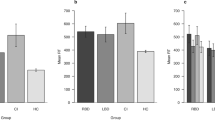Summary
The contradictory results concerning the influence of task complexity on reaction time impairments following brain damage were reconsidered in this study. Patients with damage of the right or left cerebral hemispheres, as well as neurological patients without CNS lesions and normal controls were examined by four reaction tasks of varying complexity, a simple visual or auditory task and a choice reaction task. While there was no statistical interaction between the task-complexity and group effects for the brain-damaged and non-brain-damaged patients, comparison of the performance of brain-damaged patients and normal controls revealed such an interaction. Furthermore, the patients with damage of the right cerebral hemisphere showed a more distinct impairment of reaction time with the simple visual reaction task, while the patients with damage of the left cerebral hemisphere showed a more distinct impairment with the choice reaction task. These results are discussed in connection with several self-evaluations of the patients' performance and state of health.
Zusammenfassung
Die in der Literatur widersprüchlichen Ergebnisse zum Einfluß des Komplexitätsgrades der Aufgabe auf die Reaktionsbeeinträchtigungen nach Hirnschädigungen wurden in dieser Untersuchung aufgegriffen. Je eine rechtsbzw. linkshemisphärisch hirngeschädigte Gruppe, eine neurologische Patientengruppe ohne ZNS-Schädigung und eine normalgesunde Kontrollgruppe wurden mit vier verschieden komplexen Reaktionsaufgaben am Wiener Determinationsgerät sowie je einer einfachen visuellen bzw. auditiven und einer Wahlreaktionsaufgabe am Wiener Reaktionsgerät untersucht. Während die hirngeschädigten und nicht hirngeschädigten Patienten sich bezüglich des Einflusses des Komplexitätsgrades der Aufgabe auf die Reaktionszeit nicht unterscheiden, findet sich beim Vergleich der Reaktionsleistungen der beiden Hirngeschädigtengruppen und der normalgesunden Kontrollgruppe eine statistisch signifikante Wechselwirkung zwischen dem Faktor „Komplexitätsgrad der Aufgabe” und dem Faktor ”Gruppe”. Außerdem zeigen die Patienten mit rechtsseitigen Schädigungen deutlichere Beeinträchtigungen der Reaktionsschnelligkeit bei den einfachen Reaktionsaufgaben, während die linkshemisphärisch Hirngeschädigten deutlicher bei der Wahlreaktionsprüfung beeinträchtigt sind. Die Ergebnisse werden im Zusammenhang mit verschiedenen Leistungs- und Befindlichkeitsselbsteinschätzungen der Probanden diskutiert.
Similar content being viewed by others
Literatur
Benton AL, Blackburn HL (1957) Practice effects in reaction-time tasks in brain-injured patients. J Abnorm Soc Psychol 54:109–113
Benton AL, Joynt RJ (1958) Reaction time in unilateral cerebral disease. Confin Neurol 19:247–256
Blackburn HL, Benton AL (1955) Simple and choice reaction time in cerebral disease. Confin Neurol 15:327–338
Bruhn P, Parsons OA (1971) Continuous reaction time in brain damage. Cortex 7:278–291
Dee HL, van Allen MV (1973) Speed of decision-making processes in patients with unilateral cerebral disease. Arch Neurol 28:163–166
De Renzi E, Faglioni P (1965) The comparative efficiency of intelligence and vigilance tests in detecting hemispheric cerebral damage. Cortex 1:410–433
Dimond SJ (1979) Performance by split-brain humans on lateralized vigilance tasks. Cortex 15:43–50
Dimond SJ, Beaumont JG (1973) Difference in the vigilance performance of the right and left hemisphere. Cortex 9:259–265
Hartje W, Sturm W (1982) Psychomotorische Störungen. In: Poeck K (Hrsg) Klinische Neuropsychologie. Thieme, Stuttgart
Heilman KM, van den Abell T (1979) Right hemispheric dominance for mediating cerebral activation. Neuropsychologia 17:315–321
Hosokawa T, Isagoda A, Shibuya H (1977) Visual matching, depth perception and continuous reaction time in patients with unilateral hemisphere lesions. Tohuku Psychol Folia 36:1–4
Howes D, Boller F (1975) Simple reaction time: Evidence for focal impairments from lesions of the right hemisphere. Brain 98:317–332
Huyn S, Feldt LS (1976) Estimation of the Box Correction for degrees of freedom from sample data in the randomized block and splitplot designs. J Educ Stat 1:69–82
Kirk RE (1968) Experimental design. Procedures for the behavioral sciences. Brooks & Cole, Belmont
Klensch H (1973) Die diagnostische Valenz der Reaktionszeitmessung bei verschiedenen cerebralen Erkrankungen. Fortschr Neurol Psychiatr 41:575–581
Lehmann HJ, Hauss K, Jainz M (1972) Störungen der Reaktion auf optische Signale bei Multipler Sklerose. Arch Psychiatr Nervenkr 216:371–378
Miller E (1970) Simple and choice reaction time following severe head injury. Cortex 6:121–127
Nakamura R, Taniguchi R (1977) Reaction time in patients with cerebral hemiparesis. Neuropsychologia 15:845–848
Parsons OA, Bruhn P (1973) Effects of interstimulus interval on continuous choice reaction time performance in brain-damaged, alcoholic and control patients. Cortex 9:176–182
Poeck K (1982) Anosognosie und halbseitige Vernachlässigung. In: Poeck K (Hrsg) Klinische Neuropsychologie. Thieme, Stuttgart
Rey ER, Bueckart G, Oldigs J (1983) Aufmerksamkeitsverän-derungen bei Hirntraumatikern: Eine experimentalpsychologische Untersuchung mit Hilfe von Reaktionszeitaufgaben. Vortr 20. Tagung Deutsche Gesellschaft f Hirntraumatologie und klinische Hirnpathologie eV, Mannheim
Smith KU (1947) Bilateral integrative action of the cerebral cortex in man in verbal association and sensory motor coordination. J Exp Psychol 37:367–376
Sturm W (1983) Die neuropsychologische Relevanz einfacher und komplexer Reaktions- und Konzentrationsuntersuchungen bei Hirnkranken unter Berücksichtigung ätiologischer und lokalisatorischer Gesichtspunkte. Unveröffentlichte Dissertation, Trier
Talland GA (1963) Alcoholism and reaction time. Q J Stud on Alcohol 24:38–43
Van Zomeren AH, Deelman BG (1976) Differential effects of simple and choice reaction after closed head injury. Clin Neurol Neurosurg 79:81–90
Author information
Authors and Affiliations
Additional information
Professor Dr. Klaus Poeck zum 60. Geburtstag gewidmet
Rights and permissions
About this article
Cite this article
Sturm, W., Büssing, A. Einfluß der aufgabenkomplexität auf hirnorganische reaktionsbeeinträchtigungen —hirnschädigungs- oder patienteneffekt?. Eur Arch Psychiatr Neurol Sci 235, 214–220 (1986). https://doi.org/10.1007/BF00379977
Received:
Issue Date:
DOI: https://doi.org/10.1007/BF00379977




